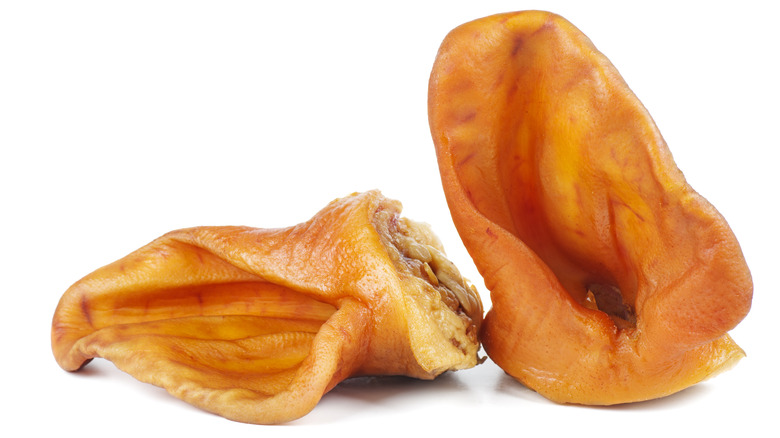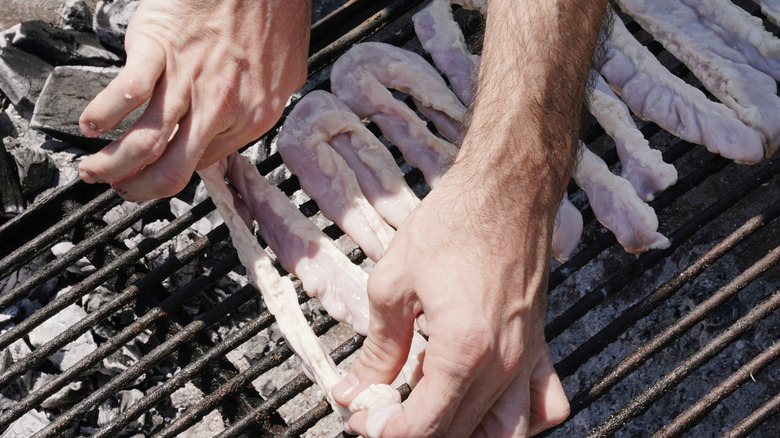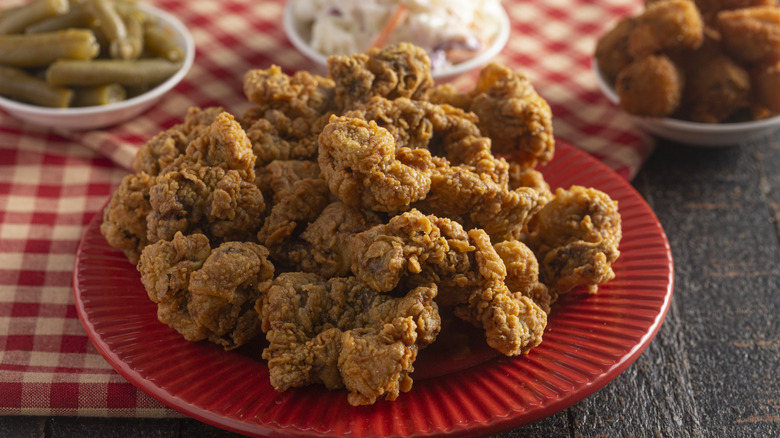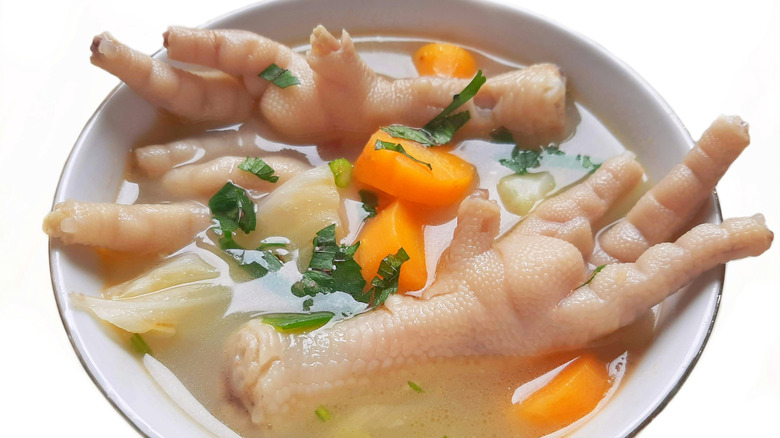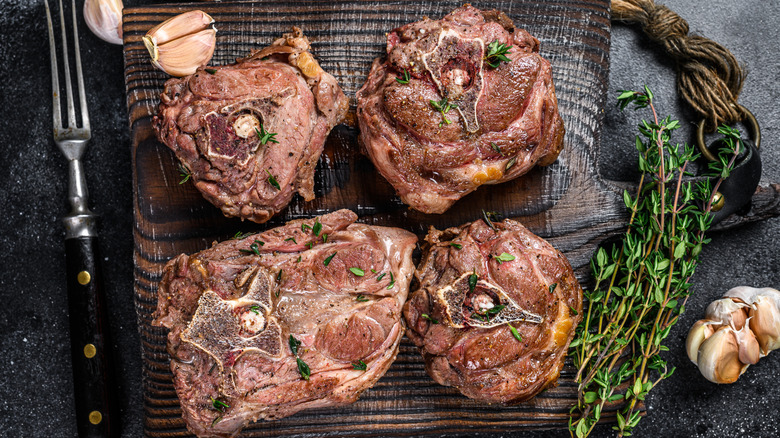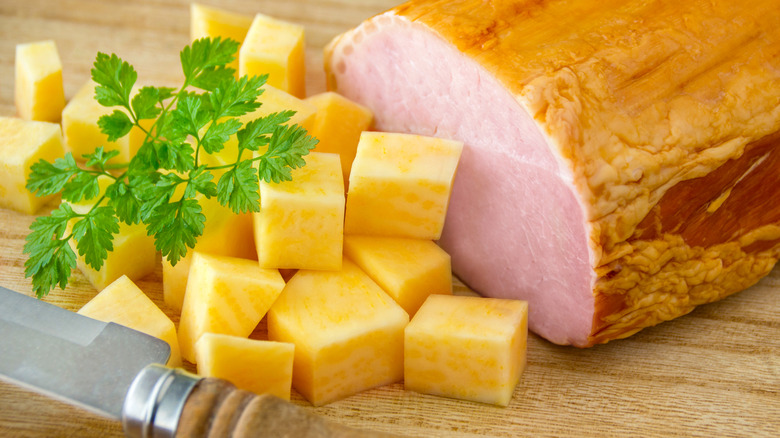9 Once-Popular Soul Food Dishes That Are Disappearing From The Table
When people think of soul food, they typically think of crispy fried chicken, savory collard greens, and creamy chicken and dumplings. They also think of the American South, which undeniably has a claim to fame when it comes to comfort food.
The South has a rich culinary history that's evolved through times of hardship and brilliant innovation. However, naturally, some once-loved dishes have fallen out of favor over the years. While many family recipes are still passed down over generations, you won't necessarily see them served in restaurants. These dishes may not go extinct entirely, but they've become rare pieces of food history that fewer and fewer people get to taste.
What kinds of foods used to be popular in the South, and why did people eat them so often? Read on to sink your teeth into some disappearing soul food dishes that used to be all the rage, but are now almost unheard of in the modern day.
Hog's head cheese
Hog's head cheese is, in fact, made of pig head, but it isn't actually cheese. Instead, the word cheese is meant to describe the texture of the dish, which is sliceable and creamy. Those who still eat hog's head cheese enjoy it on crackers or sandwiches.
Making traditional hog's head cheese involves brining a hog's head for a day or two, then cooking the head with some vegetables in water. A handful of steps later, you combine the thickened stock with chunks of pig head meat, pack it into a loaf pan, and refrigerate it until everything comes together. The collagen from the pig's head essentially creates gelatin, which allows it to maintain the shape of meatloaf, but also a soft, decadent mouthfeel.
Hog's head cheese originally provided a great way to use up an entire pig, rather than being wasteful. When more Southerners raised their own pigs, this dish made a lot of sense, but it's easy to understand why it's no longer popular today. Even the name of the dish may have some people feeling squeamish. Plus, the preparation is labor-intensive, and it forces you to come face-to-face with a disembodied pig head. If you'd like to try it, but don't have easy access to a butcher, you can find some recipes that teach home cooks how to recreate the old-school dish using more common pig parts, like the trotters.
Pig ear sandwiches
Compared to something like hog's head cheese, pig ear sandwiches may sound divine, or at least tame. But Americans don't regularly spot pig ears in grocery stores, even though they are a beloved ingredient in many global cuisines. Home chefs in the U.S. are more accustomed to buying their meat neatly cut, so it's ready to bake, grill, or fry. As a result, pig ear sandwiches faded into obscurity.
Working with pig ears requires special care, since they have a high percentage of cartilage, rather than meat. Many experts recommend using a pressure cooker to effortlessly achieve a palatable texture in a short amount of time. A traditional pig ear sandwich is then assembled using cooked pig ears, hot sauce, mustard, and shredded cabbage.
This simple preparation is meant to highlight the pig ear itself. If you're open to trying new textures, you may discover that pig ears can make for an interesting canvas, and that they work well with a wide range of flavors. There are a handful of Southern restaurants that still serve pig ear sandwiches, so there are still opportunities to try the delicacy, if you'd like. Anthony Bourdain was a huge fan of pig ear sandwiches, so it might be worth giving them a shot. Perhaps you'll be part of a movement to bring this ingredient back into the spotlight.
Brunswick stew
You may recognize the name of Brunswick stew, but you might not know that the ingredients have changed over time to fit modern consumption. Back in the day, folks in the South used to catch their own squirrels and rabbits to make Brunswick stew. But if you've tasted Brunswick stew in recent years, it was more likely prepared with chicken, pork, or another common meat.
Other components of a traditional Brunswick stew are vegetables like corn that has been sliced off the cob, lima beans, okra, potatoes, tomatoes, onion, hot peppers, and peas. Like those of other iconic soups and stews, the goal of Brunswick stew was to use up any produce that could grow in the local climate. It also ensured that nothing went to waste, and that every belly was filled to the brim.
While the original versions of Brunswick stew may no longer be popular, it's still easy to make a modern iteration. Thanks to canned and frozen veggies, whipping up a nutritious stew is a quick and painless process. You don't need to maintain your own garden, or learn how to hunt wild animals — unless you want to, of course.
Fried rabbit
Chicken holds fast to its reputation as the ultimate lean protein, in part because it's easy to find. Gone are the days of raising chickens, slaughtering them, and breaking them down yourself to make Southern-style fried chicken, and other popular dishes. Pretty much any major grocery store will have whole chickens, breasts, thighs, and other parts.
Fried rabbit hasn't endured in a similar way. Since rabbit meat is harder to come by in a commercial setting, the only folks who still prepare it are the ones who raise or catch the rabbits themselves, and those who seek out rabbit meat from specialty shops. Rabbit meat is therefore unsurprisingly more expensive than chicken meat. But if you're able to find rabbit meat, you can treat it like chicken, and cook it in the same ways. Frying is a recommended method, because the oil adds some much-needed moisture to the lean meat. For best results, brine it before dredging it in a mixture of buttermilk and flour. Fry the breaded rabbit quickly, keeping a close eye on it to avoid overcooking, as this will dry it out. The decadent, crunchy exterior adds extra oomph, and may make you wish we had a Kentucky Fried Rabbit franchise in America.
Chitlins
Were you traumatized as a kid after someone told you that hot dogs are actually a bunch of ground-up mystery pig parts shoved into intestines? As it turns out, there are a lot of false facts about hot dogs that we still believe. While it's true that intestines were used as hot dog casings when they were first invented, most grocery store brands now use more palatable ingredients. And, since hearing the rumors about the American staple, most of us were able to overcome our initial shock. While hot dogs remain a popular food, other types of dishes that feature intestines have not fared so well. One of those is chitlins, a dish that many Americans have never even heard of because we don't have the stomachs to actually cook with pig intestines in our own kitchens.
To avoid getting sick, and also avoid ruining the flavor, it's important to know how to clean chitlins. You should also know, there's an unpleasant scent that can fill the house while chitlins cook. To make matters worse, Southerners suggest the low and slow method of cooking, which means that you have to tolerate the smell for a long time. This is why lots of folks used to cook their chitlins outside, to keep their families fed when more desirable animal parts weren't readily available. Nowadays, just like hot dogs made with intestines, traditional chitlins have essentially disappeared from the dinner table.
Southern fried chicken gizzards
Many don't know the truth about chicken gizzards, those fascinating organs that allow birds to eat seeds and nuts with tough shells. For generations, Southerners have loved frying gizzards. The delicacy allows them to reap the benefits of nutrient-dense organ meat, while also enjoying the decadence of fried food. It's the perfect balance, and a great way for those who raise their own chickens to avoid wasting any part of them. Yet, while some intrepid home chefs work to keep the dish alive, it has become harder to come by.
Like when cooking chicken livers, properly preparing gizzards involves first rinsing them well, then adding lots of seasoning to complement the strong flavor. Making delicious chicken gizzards also requires the extra step of simmering them for a couple of hours. It may also be possible to use a pressure cooker to thoroughly cook the meat, and keep it tender and juicy. If you skip the slow-cooking step, and go straight to dredging and frying, you'll either end up with raw meat, or a tough texture — and no one wants either of those. Once you've fried up your gizzards, serve them with other Southern staples, like collard greens, fried okra, cornbread, and macaroni and cheese.
Chicken feet stew
In other countries, chicken feet are a desirable delicacy. In the U.S., however, the ingredient is controversial. While they may be unsightly if you're not used to them, including chicken feet in your stew adds great nutritional benefits in the form of a hefty punch of collagen. If you can't get on board with the celebrities who love to drink bone broth, then chicken feet could be a brilliant way to get more collagen into your diet. While Southerners of the past had no issue chowing down on the feet, nowadays, many remove them from the stew after simmering, right before eating. (Yes, they still reap the health benefits this way.)
If you plan on cooking with chicken feet, keep in mind that you will first need to play the role of mad manicurist, and remove the nails. Cook them for as long as possible to maximize both the flavor of the broth, and the collagen content. To make this process simple and safe, you can simmer your chicken feet in a crockpot for 24 hours.
Neck bones
A straightforward soul food dish, neck bones are exactly what they sound like: the seasoned meat surrounding the neck bones of various animals. Southerners have cooked all kinds of neck bones, but pork has always been the most popular, with beef following.
Eating meat from an animal's neck can seem a bit eerie, especially when there are other cuts (like pork chops, and tenderloin) that don't sound as unsettling. But there's another, more practical reason why neck bones aren't a common cut of meat anymore: It's among the toughest, which means that it requires special cooking techniques. This is not beginner-friendly meat.
While neck bones are a labor of love, some Southerners still champion the dish. To make the meat more palatable, they often pan-fry the neck bones in butter for a few minutes to develop a nice crust, before baking them for about an hour. You can then add broth to the baking dish, and pop it back into the oven to cook for an additional hour. While this may not be something you can whip up on a busy weeknight, the final result is tender, and unique. And though we may no longer live in a society where minimizing food waste is a priority, neck bones deserve to have a resurgence. If you're not ready to eat neck bones as the main protein on your plate, instead consider adding them to stews to make them more succulent.
Buttered rutabagas
While no starchy vegetable has won our hearts like the potato, rutabagas have also played a large role in American history. In particular, buttered rutabagas — peeled, cubed, boiled, and cooked in lots of butter — have deep ties to the South. They are still easily accessible, but not as popular as they once were.
One reason for this is that, for many folks, rutabagas represent struggling. A modern comparison would be to how some grow to loathe instant noodles, as they make them think of being broke in college. But instead of student loans and grueling homework assignments, rutabagas remind people of barely scraping by during wartime. Both world wars forced many folks to eat their fair share of rutabagas, as the vegetable has always been easy to grow. Rutabagas are still a nutritious and filling starch, but the negative associations have led Southerners to abandon the classic side dish.
Another reason why rutabagas haven't had a big resurgence, despite the distance we've gained from those traumatic times, is that they're not as simple to prepare as potatoes. Potato skin is easy to peel, and you can choose to leave it on for extra nutrients, and texture. Rutabagas, on the other hand, have a tough, waxy skin that takes more work. But, if you're looking to cut back on carbs, you'd benefit from incorporating this root vegetable into your meal rotations. Rutabagas can scratch the itch for potatoes, but they only have about a third of the carbs.


